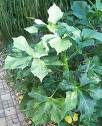
Record display
 PROTA4U Homepage
PROTA4U Homepage Select translation pop-up: Select translation pop-up: |
 |
PROTA4U Record display |
 PROTA4U Homepage PROTA4U Homepage
|
| Contrib. Gray Herb. n.s. 68: 86 (1923). | |||
| show more data (5) | comments (0) |
| Euphorbiaceae | |||
| show more data (12) | comments (0) |
| Jatropha aconitifolia Mill. (1768), Jatropha napaeifolia Desr. ex A.Juss. (1824), Cnidoscolus napaeifolius (A.Juss.) Pohl (1827). | |||
| show more data (43) | comments (0) |
| Chaya, tree spinach, cabbage star (En). Manioc bâtard (Fr). | |||
| show more data (8) | comments (0) |
| Cnidoscolus aconitifolius possibly originated in the Yucatan region of Mexico, but is now widespread in eastern Mexico and Central America. It is also cultivated from northern Mexico to Guatemala and occasionally elsewhere, e.g. in Ghana and Nigeria, where it has been experimentally planted in research stations. | |||
| show more data (13) | comments (0) |
| Young chaya leaves and shoots are cooked and eaten, alone or in combination with other vegetables and meat in stews and soups. The leaves are only rarely eaten raw as fresh greens. A popular drink in Yucatan (Mexico) is made by blending raw chaya leaves in sugar water with lemons, pineapple and other fruits and is said to heighten virility. Chaya is also used as forage for domestic animals. Medicinally, chaya has numerous characteristics, ranging from the ability to strengthen fingernails and darken graying hair. It is also used to cure alcoholism, diabetics, insomnia, skin disorders, venereal diseases, gout, scorpion stings and to improve brain function and memory. | |||
| show more data (6) | comments (0) |
| Fresh chaya leaves contain per 100 g edible portion: water 72–83 g, protein 4–8 g, fat 0–2.9 g, carbohydrate 6–13 g, fibre 2–3.8 g, Ca 140–500 mg, P 70–100 mg, Fe 2–11 mg, β-carotene 10–18 mg, thiamin 0.2 mg, riboflavin 0.1–0.4 mg, niacin 1.6 mg, ascorbic acid 165–318 mg (Ross-Ibarra & Molina-Cruz, 2002). It also contains HCN 27–42 mg. Uncooked chaya leaves contain cyanogenic glycosides that produce hydrogen cyanide upon tissue damage. The cooking time required to lower HCN to safe levels is about 15 minutes. Numerous flavonoid compounds have been isolated from chaya and most are kaempferol and quercetin glycosides (e.g. in the cultivated forms: 3-O-rhamnosylgalactoside-7-O-rhamnoside, 3-O-rhamnosylglucoside and 3-O-rhamnoside). Most medicinal properties have never been experimentally tested. Diabetic rabbits, fed increasingly higher quantities of chaya leaves, showed a significant drop in blood sugar levels. Chicks fed diets high in chaya leaf meal had a lower overall mass but a significant increase in absolute heart mass, liver mass, red blood cell count and a significant reduction in mortality. Chaya is known to contain proteolytic enzymes which could explain the use of chaya sap for skin disorders. | |||
| show more data (0) | comments (0) |
| Monoecious shrub or small tree up to 6 m tall, containing a white latex, with a thick pale trunk, plants usually armed with stinging hairs, but cultivated forms unarmed. Leaves alternate, simple; petiole 10–30 cm long, glandular at apex; blade very variable, 10–20(–32) cm × up to 30 cm, shallowly or deeply 3–7-lobed, cordate at base, rather thick and fleshy when fresh, subglabrous and normally without stinging bristles, lobes acute to acuminate. Inflorescence a dichotomous cyme. Flowers unisexual, regular, without petals; sepals 5, up to 1 cm long, petaloid, white; male flowers with 10 united stamens in 2 whorls; female flowers with superior, 3-celled ovary, styles 3, connate at base. Fruit an ovoid-globose, hispid capsule. Seeds 6–8 mm long, carunculate. Cnidoscolus comprises about 50 species, all American. Most species bear long stiff needle hairs, stinging the flesh much worse than most nettles, the pain often being excruciating and persistent for hours, sometimes accompanied by swelling and blistering. The genus is closely related to Jatropha and was combined with it in the past. At present it is considered nearer to Manihot. Cnidoscolus aconitifolius is divided into 2 subspecies. Subsp. polyanthus (Pax & K.Hoffm.) Breckon is restricted to a small area in western Mexico. Subsp. aconitifolius is distributed from northern Mexico to Guatemala, and is cultivated up to Peru and occasionally elsewhere. Forms without stinging hairs used as a vegetable are classified as a cultivar-group: Chayamansa Group (synonym: Cnidoscolus chayamansa McVaugh). Plants of this cultivar-group produce functionally sterile flowers (very rarely fruits are produced) and are propagated by cuttings; at least 4 cultivars are known: ‘Chayamansa’ (leaf blade with 5 obovate, strongly overlapping lobes; this is the most common cultivar), ‘Estrella’ (leaf blade with 5 spreading, not overlapping, dentate lobes), ‘Picuda’ (leaf blade with 5–9, narrow, strongly dentate to pinnatifid lobes) and ‘Redonda’ (leaf blade with 3 entire to slightly dentate lobes). | |||
| show more data (0) | comments (0) |
| show more data (1) | comments (0) |
| Under natural conditions in Central America Cnidoscolus aconitifolius grows in moist and dry thickets in open forest, often in open rocky localities, from sea-level up to 1300 m altitude. | |||
| show more data (0) | comments (0) |
| Chaya is propagated by stem cuttings about 40 cm long, that are dried 1–14 days before being planted. It can survive harsh conditions of high temperatures, deep shade, inundations or droughts. It is mostly planted as a hedge in home gardens. Although the plant can reach 6 m in height, the stems are easily broken by wind and it is recommended that a height of less than 2 m be maintained. Harvesting is best done with protected hands, because even in unarmed plants, long-term contact with the white sap can cause skin irritation. Annual dry leaf yields of up to 12 t/ha are possible on fertile soil with about 9000 plants/ha. The optimum harvest period is only 2–3 months per year, but in home gardens leaves are harvested when needed. Serious diseases and pests are not known. | |||
| show more data (0) | comments (0) |
| Cnidoscolus aconitifolius is widespread in Central America and not in danger of genetic erosion. | |||
| show more data (0) | comments (0) |
| Chaya has potential as a home garden crop. With its easy propagation, its tolerance of harsh conditions and absence of serious diseases or pests, it is a promising species worthwhile trying in many locations in tropical Africa. | |||
| show more data (0) | comments (0) |
| • Kolterman, D.A., Breckon, G.J. & Kowal, R.R., 1984. Chemotaxonomic studies in Cnidoscolus (Euphorbiaceae). 2. Flavonoids of C. aconitifolius, C. souzae, and C. spinosus. Systematic Botany 9(1): 22–32. • Ross-Ibarra, J. & Molina-Cruz, A., 2002. The ethnobotany of chaya (Cnidoscolus aconitifolius ssp. aconitifolius Breckon): a nutritious Maya vegetable. Economic Botany 56(4): 350–365. • Standley, P.C. & Steyermark, J.A., 1949. Flora of Guatemala. Fieldiana: Botany 24, part 6: 1–440. | |||
| show more data (43) | comments (0) |
| • Burkill, H.M., 1994. The useful plants of West Tropical Africa. 2nd Edition. Volume 2, Families E–I. Royal Botanic Gardens, Kew, Richmond, United Kingdom. 636 pp. • National Academy of Sciences, 1975. Underexploited tropical plants with promising economic value. National Academy of Sciences, Washington D.C., United States. 188 pp. | |||
| show more data (13) | comments (0) |
| show more data (4) | comments (0) |
| |||||
| |||||||
| |||||||
| |||||||
| Jansen, P.C.M., 2004. Cnidoscolus aconitifolius (Mill.) I.M.Johnst. [Internet] Record from PROTA4U. Grubben, G.J.H. & Denton, O.A. (Editors). PROTA (Plant Resources of Tropical Africa / Ressources végétales de l’Afrique tropicale), Wageningen, Netherlands. <http://www.prota4u.org/search.asp>. Accessed . | |||
| There are 3 study abstracts related to Cnidoscolus aconitifolius (Mill.) I.M.Johnstone. Click on "show more" to view them. | ||
| show more data | comments (0) |
| There are 107 book citations related to Cnidoscolus aconitifolius (Mill.) I.M.Johnstone. Click on "show more" to view them. | ||
| show more data | comments (0) |
| There are 224 citation in web searches related to Cnidoscolus aconitifolius (Mill.) I.M.Johnstone. Click on "show more" to view them. | ||
| show more data | comments (0) |
| There are 115 citation in scholarly articles related to Cnidoscolus aconitifolius (Mill.) I.M.Johnstone. Click on "show more" to view them. | ||
| show more data | comments (0) |
| There are 3 news article citations related to Cnidoscolus aconitifolius (Mill.) I.M.Johnstone. Click on "show more" to view them. | ||
| show more data | comments (0) |
| There are 7 citations in Afrirefs related to Cnidoscolus aconitifolius (Mill.) I.M.Johnstone. Click on "show more" to view them. | ||
| show more data | comments (0) |
| There are 3 Wikipedia citations related to Cnidoscolus aconitifolius (Mill.) I.M.Johnstone. Click on "show more" to view them. | ||
| show more data | comments (0) |
| General importance |  |
| Geographic coverage Africa |  |
| Geographic coverage World |  |
| Vegetables |  |
| Ornamental use |  |
| Forage/feed use |  |
| Medicinal use |  |
| Food security |  |

